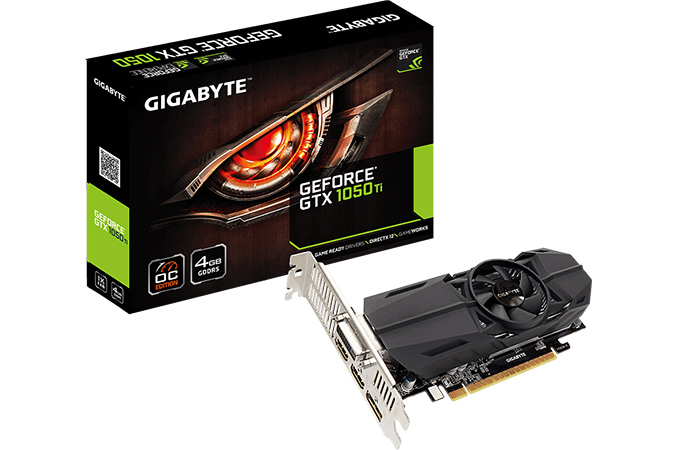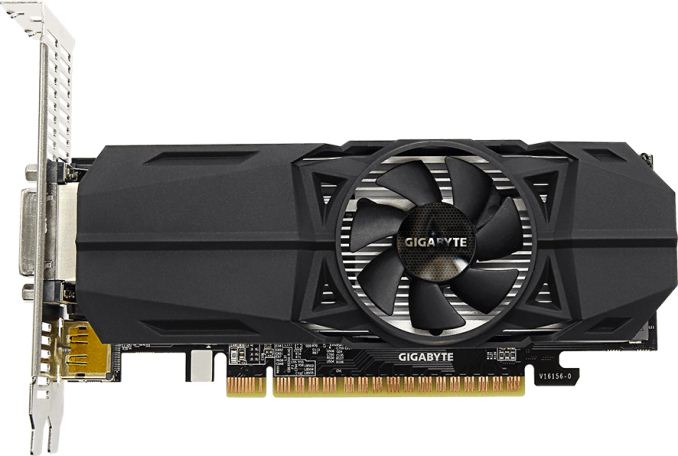GIGABYTE Quietly Launches Low Profile GeForce GTX 1050, 1050 Ti Graphics Cards
by Anton Shilov on January 10, 2017 5:00 PM EST
GIGABYTE has quietly added two low-profile video cards to its lineup of products during CES. The graphics adapters are based on NVIDIA’s GeForce GTX 1050-series GPUs and will be among the most affordable gaming-grade products in the company’s family. The new low-profile add-in-cards will be especially useful for those building mini PCs or HTPCs as well as for those upgrading inexpensive computers from OEMs.
GIGABYTE’s GeForce GTX 1050 Ti OC Low Profile 4G and GeForce GTX 1050 OC Low Profile 2G graphics adapters are based on NVIDIA’s GP107 GPU (albeit, in different configurations) and carry 4 GB and 2 GB of GDDR5 memory running at 7 Gbps, respectively. Both cards use the same PCB (marked as V16156-0) as well as the dual-slot cooling system featuring an aluminum heatsink and a fan. As for connectivity, the boards also have a similar set of outputs: one DL-DVI-D, two HDMI 2.0b and one DisplayPort 1.4 with HDCP 2.2 support that is required for Ultra HD Blu-ray playback.
It is noteworthy that GIGABYTE decided to slightly increase GPU clock-rates of its low-profile GeForce GTX 1050-series graphics cards versus NVIDIA’s reference designs to give them some extra punch over rivals. Meanwhile, TDP and power requirements of its low profile GTX 1050-series graphics cards remained at approximately 75 W level, which means no additional power connectors are required and the cards can be installed into any contemporary computer with a PCIe x16 slot.
| Specifications of Low Profile GeForce GTX 1050-Series Graphics Cards | ||||||||
| GIGABYTE 1050 Ti OC LP 4G |
MSI 1050 Ti LP 4G |
GIGABYTE 1050 OC LP 2G |
MSI GTX 1050 LP 2G |
|||||
| SKU | GV-N105TOC-4GL | GV-N1050OC-2GL | ||||||
| Stream Processors | 768 | 640 | ||||||
| Texture Units | 48 | 40 | ||||||
| ROPs | 32 | |||||||
| Core Clock (MHz) | 1303 - 1328 | 1290 | 1366 - 1392 | 1354 | ||||
| Boost Clock (MHz) | 1417 - 1442 | 1392 | 1468 - 1506 | 1455 | ||||
| Memory | Capacity | 4 GB | 2 GB | |||||
| Type | GDDR5 | |||||||
| Clock | 7 Gbps | |||||||
| Bus Width | 128 bit | |||||||
| Outputs | DisplayPort | 1 × DP 1.4 | ||||||
| DVI | 1 × DVI-D | |||||||
| HDMI 2.0b | 2 | 1 | 2 | 1 | ||||
| TDP | 75 W | |||||||
| Launch Date | 1/2017 | 11/2016 | 1/2017 | 11/2016 | ||||
It seems like low profile graphics cards are back courtesy of NVIDIA’s GeForce GTX 1050-series as GIGABYTE is the second company to announce such parts after MSI, and it likely that these two companies will not be the only suppliers of such products. For those building low-power HTPCs or upgrading entry-level PCs, the GP107-based graphics adapters seem to be a good choice because the GPU supports DirectX 12 and Vulkan APIs as well as has an advanced media playback engine that features hardware-accelerated decoding and encoding of H.265 (HEVC) video.
GIGABYTE does not specify MSRPs for its GeForce GTX 1050 Ti OC Low Profile 4G and GeForce GTX 1050 OC Low Profile 2G graphics adapters on its web-site, as these are typically determined at regional release. Given the positioning of these products, it unlikely that they will cost significantly more than NVIDIA’s MSRPs for similar video cards: $139 for the GTX 1050 Ti and $109 for the GTX 1050.
Related Reading:
Source: GIGABYTE

















23 Comments
View All Comments
aron304 - Tuesday, February 21, 2017 - link
https://www.newegg.com/Product/Product.aspx?Item=N...this is probably your best bet. Rx 460 single slot 4gb
Meteor2 - Wednesday, January 11, 2017 - link
Where has the search box gone?! I was going to search Anandtech to see if there's been a GTX1050 review (I can't remember), but it seems the search function is MIA.BrokenCrayons - Wednesday, January 11, 2017 - link
There hasn't been a GPU review for the 1050 or the RX460 and RX470 done by Anandtech yet.banaz - Wednesday, January 11, 2017 - link
still no option for a completely passive 1050ti ??DanNeely - Thursday, January 12, 2017 - link
It's a 75W part. You're not going to get a passive card out of it. You'll need to wait for nVidia to get around to releasing the lower power GP108 first.80-wattHamster - Monday, January 16, 2017 - link
It might be possible binned and/or downclocked. There were passive versions of the R7 250, which pulled almost as much power.TheinsanegamerN - Wednesday, January 11, 2017 - link
WHY do they have that DVI port? It's such an old, obsolete connector, and you could just include a displayport--->DVI cable, and give us a single slot card!And yes, I know the heatsink is dual slot, but the single slot bracket/dual slot cooler would fit in a lot of machines, such as the older BTX optiplex machines these cards are often put in, as well as modded in win chopin style cases, or modded BP655 chassis. The DVI port makes all that impossible.
Of course, this wouldnt be an issue if more low profile cases had two expansion slots.
DanNeely - Wednesday, January 11, 2017 - link
Because only DP to singlelink DVI can be done with a cheap passive dongle (that basically just tells the GPU to output DVI/HDMI on this port not DP). DP-duallink DVI (needed for older 1440/1600p displays) needs an active adapter that has a microcontroller/fpga/asic capable of doing protocol translation (DP doesn't have enough wires to carry all the data lines in dual link DVI, so the simpler option isn't available here). With the exception of a single $30ish adapter with horrible Newegg reviews, the ballpark cost for something capable of doing this is $100ish.OTOH having finally delivered on retiring analog VGA out last summer (a few years after they originally agreed to); GPU makers might follow through on retiring DVI in the next few years too. IIRC the original timelines were 2013 to pull the plug on VGA and 2015 for DVI; with only Intel more or less hitting the original dates.
DanNeely - Wednesday, January 11, 2017 - link
... that said I wouldn't be surprised if DVI does linger significantly longer due to the cost of the DP to DL-DVI converter being so much higher than an HDMI/DP to VGA one.HomeworldFound - Thursday, January 12, 2017 - link
Probably, considering the bugs that DP introduces into the mix. It's not time to get rid of older standards yet.